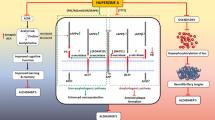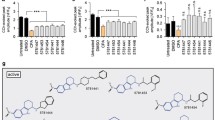Abstract
The accumulation of amyloid-beta and concomitant oxidative stress are major pathogenic events in Alzheimer’s disease. Indole-3-propionic acid (IPA, OXIGON™) is a potent anti-oxidant devoid of pro-oxidant activity. IPA has been demonstrated to be an inhibitor of beta-amyloid fibril formation and to be a potent neuroprotectant against a variety of oxidotoxins. This review will summarize the known properties of IPA and outline the rationale behind its selection as a potential disease-modifying therapy for Alzheimer’s disease.
Similar content being viewed by others
References
Ames B. N., Shigenaga M. K., and Hagen T.M. (1993) Oxidants, antioxidants, and the degenerative diseases of aging. Proc. Natl. Acad. Sci. USA 90, 7915–7922.
Aust A. E. and Eveleigh J. F. (1999) Mechanism of DNA oxidation. Proc. Soc. Exp. Biol. Med. 222, 246–252.
Beal M. F. (1995) Aging, energy, and oxidative stress in neurodegenerative diseases. Ann. Neurol. 38, 357–366.
Behl C., Davis J., Cole G. M., and Schubert D. (1992) Vitamin E protects nerve cells from amyloid-beta protein toxicity. Biochem. Biophys. Res. Comm. 186, 944–950.
Chyan Y.-J., Poeggeler B., Omar R. A., Chain D. G., Frangione B., Ghiso J., and Pappolla M. A. (1999) Potent neuroprotective properties against the Alzheimer β-amyloid by an endogenous melatonin-related indole structure, indole-3-propionic acid. J. Biol. Chem. 274, 21937–21942.
Delanty N. and Dichter M. A. (2000) Antioxidant therapy in neurologic disease. Arch. Neurol. 57, 1265–1270.
Floyd R. A. (1999) Antioxidants, oxidative stress, and degenerative neurological disorders. Proc. R. Soc. Exp. Biol. Med. 222, 236–245.
Iadecola C., Zhang F., Niwa K., Eckman C., Turner S. K., Fischer E., et al. (1999) SOD1 rescues cerebral endothelial dysfunction in mice overexpressing amyloid precursor protein. Nature Neuroscience 2, 157–161.
Karbownik M., Garcia J. J., Lewiński A., and Reiter R. J. (2001a) Carcinogen-induced, free radical-mediated reduction in microsomal membrane fluidity: reversal by indole-3-propionic acid. J. Bioenerget. Biomembr. 33, 73–78.
Karbownik M., Gitto E., Lewinski A., and Reiter R. J. (2001b) Relative efficacies of indole antioxidants in reducing autoxidation and iron-induced peroxidation in hamster testes. J. Cell. Biochem. 81, 693–699.
Karbownik M., Reiter R. J., Cabrera J., and Garcia J. J. (2001c) Comparison of the protective effect of melatonin with other antioxidants in the hamster kidney model of estradiol-induced DNA damage. Mutat. Res. 474, 87–92.
Karbownik M., Reiter R. J., Garcia J. J., Cabrera J., Burkhardt S., Osuna C., and Lewiński A. (2001d) Indole-3-propionic acid, a melatonin-related molecule, protects hepatic microsomal membranes from iron-induced oxidative damage: relevance to cancer reduction. J. Cell. Biochem. 81, 507–513.
Klein W. L., Krafft G. A., and Finch C. E. (2001) Targeting small Aβ oligomers: the solution to an Alzheimer’s disease conundrum? Trends Neurosci. 24, 219–224.
Lambert M. P., Barlow A. K., Chromy B. A., Edwards C., Freed R., Liosatos M., et al. (1998) Diffusible, nonfibrillar ligands derived from Aβ1–42 are potent central nervous system neurotoxins. Proc. Natl. Acad. Sci. USA 95, 6448–6453.
Lloyd D. R., Carmichael P. L., and Phillips D. H. (1998) Comparison of the formation of 8-hydroxy-2-deoxyguanosione and single-and double-strand breaks in DNA mediated by Fenton reaction. Chem. Res. Toxicol. 11, 420–427.
Markesbery W. R. and Carney J. M. (1999) Oxidative alterations in Alzheimer’s disease. Brain Pathol. 9, 133–146.
Mattson M. P., Pedersen W. A., Duan W., Culmsee C., and Camandola S. (1999) Cellular and molecular mechanisms underlying perturbed energy metabolism and neuronal degeneration in Alzheimer’s and Parkinson’s diseases. Ann. NY Acad. Sci. 893, 154–175.
Pappolla M. A., Omar R. A., Kim K. S., and Robakis N. K. (1992) Immunohistochemical evidence of oxidative stress in Alzheimer’s disease. Am. J. Pathol. 140, 621–628.
Pereira C., Santos M. S., and Oliveira C. (1999) Involvement of oxidative stress on the impairment of energy metabolism induced by Aβ peptides on PC12 cells: protection y antioxidants. Neurobiol. Disease 6, 209–219.
Poeggeler B., Chyan Y.-J., Bryant T., Wisniewski T., Frangione B., Ghiso J., and Pappolla M. A. (1999a) Melatonin abolishes the pro-aggregatory effects of ApoE4 on the Alzheimer β-protein. Soc. Neurosci. 25(abst.), 1805.
Poeggeler B., Pappolla M. A., Hardeland R., Rassoulpour A., Hodgkins P. S., Guidetti P., and Schwarz R. (1999b) Indole-3-propionate: a potent hydroxyl radical scavenger in rat brain. Brain Res. 815, 382–388.
Praticò D. and Delanty N. (2000) Oxidative injury in diseases of the central nervous system: focus on Alzheimer’s disease. Am. J. Med. 109, 577–585.
Praticò D., Uryu K., Leight S., Trojanowski J. Q., and Lee V. M.-Y. (2001) Increased lipid peroxidation precedes amyloid plaque formation in an animal model of Alzheimer amyloidosis. J. Neurosci. 21, 4183–4187.
Qi W., Reiter R. J., Tan D.-X., Manchester L. C., Siu A. W., and Garcia J. J. (2000) Increased levels of oxidatively damaged DNA induced by chromium(III) and H2O2: protection by melatonin and related molecules. J. Pineal Res. 29, 54–61.
Reiter R. J. (1995) Oxidative processes and antioxidative defense mechanisms in the aging brain. FASEB J. 9, 526–533.
Roberts L. J. 2nd, Montine T. J., and Markesbery W. R. (1998) Formation of isoprostane-like compounds (neuroprostanes) in vivo from docosahexaenoic acid. J. Biol. Chem. 273, 13605–13612.
Rosenberg R. N. (2000) The molecular and genetic basis of AD: the end of the beginning. Neurology 54, 2045–2054.
Selkoe D. J. (2001) Alzheimer’s disease: genes, proteins and therapy. Physiological Reviews 81, 741–766.
Varadarajan S., Yatin S., Aksenova M., and Butterfield D. A. (2000) Review: Alzheimer’s amyloid β-peptide-associated free radical oxidative stress and neurotoxicity. J. Struct. Biol. 130, 184–208.
Weinberg E. D. (1996) The role of iron in cancer. Eur. J. Cancer Prevent. 5, 19–36.
Young S., Anderson G. M., Gauthier S., and Purdy W. C. (1980) The origin of indoleacetic acid and indolepropionic acid in rat and human cerebrospinal fluid. J. Neurochem. 34, 1087–1092.
Author information
Authors and Affiliations
Corresponding author
Rights and permissions
About this article
Cite this article
Bendheim, P.E., Poeggeler, B., Neria, E. et al. Development of indole-3-propionic acid (OXIGON™) for alzheimer’s disease. J Mol Neurosci 19, 213–217 (2002). https://doi.org/10.1007/s12031-002-0036-0
Received:
Accepted:
Issue Date:
DOI: https://doi.org/10.1007/s12031-002-0036-0




